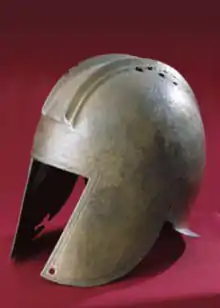Illyrian type helmet
The "Illyrian type helmet" (or "Greco-Illyrian" type helmet) is a style of bronze helmet, which in its later variations covered the entire head and neck, and was open-faced in all of its forms.[1] It originated in Peloponnese, ancient Greece,[2] and was developed during the 8th and 7th centuries BC (700–640 BC).[1][3][4] Accurate representations on Corinthian vases are sufficient to indicate that the "Illyrian" type helmet was developed before 600 BC.[5] The helmet was misleadingly named as an "Illyrian" type due to many early finds coming from Illyria.[1][6][note 1]

Archaeology
According to archaeological evidence, the "Illyrian" type helmet evolved from the Kegelhelm (or Kegel type) of the Archaic Period found in Argos.[1] The earliest "Illyrian" type helmets were developed in a workshop located in the northwestern Peloponnese (possibly Olympia), although the first Type II "Illyrian" helmets were created in Corinthian workshops.[3] The first Type III helmets were created in workshops situated somewhere on the Illyrian coast of the Adriatic.[7] The "Illyrian" type helmet did not obstruct the wearer's critical senses of vision though the first two varieties hampered hearing. There were four types of these helmets and all were open faced:
- Type I (c. 700–640 BC) left the neck unprotected and hampered hearing.
- Type II (c. 600 BC) offered neck protection and again hampered hearing.
- Type III (c. 550 BC) offered neck protection and allowed better hearing.
- Type IV (c. 500 BC) was similar to Type III but hearing was not impaired at all.
The Illyrian type helmet was used by the ancient Greeks,[8] Etruscans,[9] Scythians,[10] and became popular with the Illyrians who later adopted it.[8][11] A variety of the helm had also spread to Italy based on its appearance on ivory reliefs and on a silver bowl at the "Bernardini" tomb at Praeneste.[5] The helmet became obsolete in most parts of Greece in the early 5th century BC. Its use in Illyria had ended by the 4th century BC.[12]
Gallery
 Types of Ancient Greek helmets; top line, third from the left: "Illyrian type" helpet. Antikensammlung in Altes Museum, Berlin.
Types of Ancient Greek helmets; top line, third from the left: "Illyrian type" helpet. Antikensammlung in Altes Museum, Berlin. "Illyrian type" helmet (left) juxtaposed to a Corinthian type helmet (right).
"Illyrian type" helmet (left) juxtaposed to a Corinthian type helmet (right). "Illyrian type" helmet from Budva, Montenegro (c. 4th century BC).
"Illyrian type" helmet from Budva, Montenegro (c. 4th century BC). Illyrian-Greek helmet from Budva, Montenegro (4th century BC).
Illyrian-Greek helmet from Budva, Montenegro (4th century BC). Illyrian-Greek helmet from Kličevo, Montenegro (Upper Bronze Age).
Illyrian-Greek helmet from Kličevo, Montenegro (Upper Bronze Age). Greco-Illyrian helmet from Timis, Romania with horseman and six rose-petal decorations (6th–4th century BC).
Greco-Illyrian helmet from Timis, Romania with horseman and six rose-petal decorations (6th–4th century BC).
References
Notes
- Naming conventions and typology of ancient helmets are of modern origin and do not reflect contemporaneous usage. (Connolly 1998, p. 60: "Terms such as 'Illyrian' and 'Attic' are used in archaeology for convenience to denote a particular type of helmet and do not imply its origin.")
Citations
- Connolly 1998, p. 60.
- Bardunias & Ray 2016, p. 41: "The basic form of the early kegelhelm did not disappear. A helmet type labeled 'Illyrian' (though actually originating in the Peloponnese) was in continuous use alongside the Corinthian..."
- Treister 1996, pp. 59–62.
- Wilkes 1995, p. 108; Pearce et al. 1998, p. 242.
- Snodgrass 1964, p. 20.
- Snodgrass 1999, pp. 76, 95; Sekunda 1998, p. 53: "Figure D2, based on a Lakonian warrior statuette from Dodona, wears a helmet of the Illyrian type, so-named because many early finds came from Illyria. However, it is now clear that it was also extremely popular in the Peloponnese, which is the most probable area of origin."
- Treister 1996, p. 65: "The earliest variants of type 3 of the Illyrian helmet, dating primarily to the second half of the 6th century B.C., belong to the production of the workshops situated somewhere on the Illyrian coast of the Adriatic."
- Snodgrass 1999, p. 52: "Another common form, superficially similar to the 'Insular', is the so-called 'Illyrian' helmet, in fact a purely Greek type which perhaps originated somewhere in the Peloponnese in the earlier seventh century, and only centuries later found its way to Illyria and other barbarian lands."
- Richardson 1983, p. 165: "...Etruria to adopt Greek armor, the Cretan or Illyrian helmet and the hoplite shield..."
- Cernenko, McBride & Gorelik 1983, p. 45.
- Snodgrass 1999, p. 76.
- Wilkes 1995, p. 241.
Sources
- Bardunias, Paul M.; Ray, Fred Eugene (2016). Hoplites at War: A Comprehensive Analysis of Heavy Infantry Combat in the Greek World, 750–100 BCE. Jefferson, NC: McFarland & Company, Inc. ISBN 1-47666-602-4.
- Connolly, Peter (1998). Greece and Rome at War. London: Greenhill Books. ISBN 1-85367-303-X.
- Cernenko, E. V.; McBride, Angus; Gorelik, M. V. (1983). Scythians 700–300 B.C. London: Osprey Publishing. ISBN 0-85045-478-6.
- Pearce, Mark; Tosi, Maurizio; Moravetti, Alberto; Milliken, Sarah; Vidale, Massimo (1998). Papers from the EAA Third Annual Meeting at Ravenna 1997: Pre- and Protohistory. Oxford: Archaeopress. ISBN 0-86054-894-5.
- Richardson, Emeline Hill (1983). Etruscan Votive Bronzes: Geometric, Orientalizing, Archaic, Volume 1. Mainz am Rhein: Verlag Philipp von Zabern. ISBN 3-8053-0546-X.
- Sekunda, Nick (1998). The Spartan Army. Oxford: Osprey Publishing. ISBN 1-85532-659-0.
- Snodgrass, Anthony M. (1999) [1967]. Arms and Armor of the Greeks. Baltimore, MD: Johns Hopkins University Press. ISBN 0-8018-6073-3.
- Snodgrass, Anthony M. (1964). Early Greek Armour and Weapons: From the End of the Bronze Age to 600 B.C. Edinburgh: University of Edinburgh.
- Treister, Michail Yu (1996). The Role of Metals in Ancient Greek History. Leiden: E. J. Brill. ISBN 90-04-10473-9.
- Wilkes, John J. (1995). The Illyrians. Oxford: Blackwell Publishing Limited. ISBN 0-631-19807-5.
Further reading
- Vasić, Rastko (2010). "Reflecting on Illyrian Helmets" (PDF). Starinar. Institute of Archaeology, Belgrade. 60: 37–55.
External links
 Media related to Category:Ancient helmets at Wikimedia Commons
Media related to Category:Ancient helmets at Wikimedia Commons